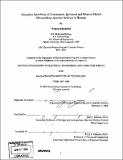| dc.contributor.advisor | John J. Guinan. | en_US |
| dc.contributor.author | Lilaonitkul, Watjana, 1975- | en_US |
| dc.contributor.other | Massachusetts Institute of Technology. Dept. of Electrical Engineering and Computer Science. | en_US |
| dc.date.accessioned | 2008-11-07T18:57:38Z | |
| dc.date.available | 2008-11-07T18:57:38Z | |
| dc.date.copyright | 2008 | en_US |
| dc.date.issued | 2008 | en_US |
| dc.identifier.uri | http://hdl.handle.net/1721.1/43060 | |
| dc.description | Thesis (Ph. D.)--Massachusetts Institute of Technology, Dept. of Electrical Engineering and Computer Science, 2008. | en_US |
| dc.description | Includes bibliographical references. | en_US |
| dc.description.abstract | A variety of evidence indicates that the brain controls the gain of mechanical amplification in the cochlea in a frequency specific manner through the medial olivocochlear (MOC) efferent pathway, but the degree of MOC frequency specificity in humans is poorly understood. This thesis investigates the tuning properties of the human MOC acoustic reflex at different cochlear frequency regions and with different MOC-elicitor lateralities and frequency contents. Effects produced by the MOC reflex were quantified by the magnitude of the induced changes in stimulus frequency otoacoustic emissions (deltaSFOAEs) at probe frequencies of 0.5, 1 and 4 kHz. With MOC activity elicited by a mid-level (60 dB SPL) tone or half-octave-band of noise, significant MOC-induced deltaSFOAEs were seen over a wide range of elicitor frequencies, e.g. for elicitor frequencies at least 11/2 octaves away from each probe frequency. deltaSFOAE-versus-elicitor-frequency patterns were sometimes skewed so that elicitors at frequencies above (0.5 kHz probe) or below (1 kHz probe) the probe frequency were most effective. In contrast to the wide frequency range of MOC effects from mid-level elicitors, for 1 kHz probes MOC-effect tuning curves (TCs) were narrow with Ql0s of -2, sharper than the MOC-fiber TCs with best frequencies near I kHz in cats and guinea pigs. When MOC effects were looked at as the MOC-inhibited SFOAE relative to the original SFOAE, the SFOAE magnitude decreases and phase changes appeared to be separate functions of elicitor frequency: SFOAE magnitude inhibition was largest for on-frequency elicitors (elicitor frequencies near the probe frequency) while MOC-induced SFOAE phase leads were largest for off-frequency elicitors. | en_US |
| dc.description.abstract | (cont) One hypothesis to account for this is that on-frequency elicitors predominantly inhibit the traveling wave from the probe-tone, whereas off-frequency elicitors shift it along the frequency axis by selectively inhibiting apical or basal parts of the traveling-wave. These results are consistent with an anti-masking role of MOC efferents and suggest that MOC efferents do more than just provide feedback to a narrow frequency region around the elicitor frequency. | en_US |
| dc.description.statementofresponsibility | by Watjana Lilaonitkul. | en_US |
| dc.format.extent | 153 p. | en_US |
| dc.language.iso | eng | en_US |
| dc.publisher | Massachusetts Institute of Technology | en_US |
| dc.rights | M.I.T. theses are protected by
copyright. They may be viewed from this source for any purpose, but
reproduction or distribution in any format is prohibited without written
permission. See provided URL for inquiries about permission. | en_US |
| dc.rights.uri | http://dspace.mit.edu/handle/1721.1/7582 | en_US |
| dc.subject | Electrical Engineering and Computer Science. | en_US |
| dc.title | Frequency specificity of contralateral, ipsilateral and bilateral medial olivocochlear acoustic reflexes in humans | en_US |
| dc.type | Thesis | en_US |
| dc.description.degree | Ph.D. | en_US |
| dc.contributor.department | Massachusetts Institute of Technology. Department of Electrical Engineering and Computer Science | |
| dc.identifier.oclc | 244102847 | en_US |
